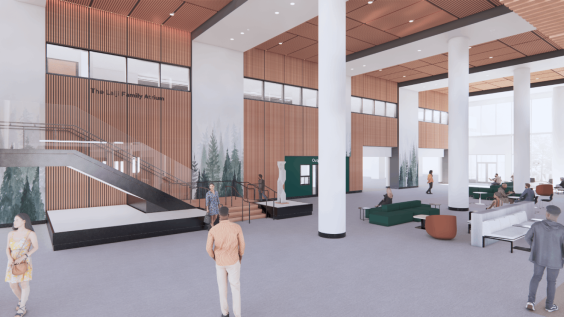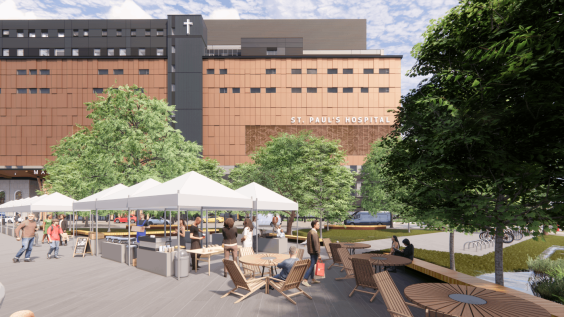The new St. Paul’s Hospital will be a game-changer in B.C, enhancing the way health care is delivered while also addressing the challenges posed by climate change. When the hospital opens in 2027, it will be a LEED-certified building, recognized for its commitment to green building standards.
But the hospital’s sustainability efforts extend far beyond certification requirements, surpassing even the stringent benchmarks set by the City of Vancouver for sustainable site design, access to nature, green mobility, zero-waste planning, and low-carbon energy use.
“We aimed not just for compliance, but for true leadership in green and resilient design,” says Molly Leathem, project manager with the New St. Paul’s Hospital Project Team.
“For example, the new St. Paul’s will be built five metres above the sea-level rise predicted by the year 2100 so it can continue operating in the event of a major flood. We’ve also designed our mechanical systems for air quality and cooling based on temperatures predicted by the year 2080. From conception to construction, every decision is guided by our dedication to building a resilient hospital that minimizes our ecological footprint.”
Minimizing environmental impact
It’s estimated Canadian health care systems contribute 4.6% of greenhouse gas emissions from lighting, cooling and heating hospitals, single-use medical items such as syringes, and other standard practices used in health care facilities.
At the new St. Paul’s Hospital, every design and construction detail is aimed at either maximizing efficiency or minimizing our environmental impact. Examples include a window-to-wall ratio designed to reduce energy consumption while maximizing natural light, advanced metres and analytics to track and identify energy savings, and building materials and finishes selected to reduce waste, among many other features.

“We’re implementing innovative technologies like heat recovery chillers to reduce energy demands, and sustainable waste management practices to divert construction debris from landfills,” says Leathem. “Our team has explored opportunities at every turn to ensure we’re doing our part to reduce greenhouse gas emissions.”
Promoting greener commutes and wellness
Promoting greener commutes and wellness are integral parts of the hospital’s vision for sustainability. The campus is designed to make all modes of travel safe, convenient, comfortable, and fun for people of all ages and abilities, reflecting the City of Vancouver’s goals outlined in the Transportation 2040 Plan.

“We’re fostering a culture of eco-friendly transportation,” says Leathem. “With designated bike lanes, 100+ electric car charging stations, and convenient access to public transit, we’re empowering staff and visitors to embrace sustainable travel options.”
To encourage biking to work, staff will have access to a 24/7 safe and secure Cycling Centre which has capacity for 200 bikes, plus lockers, showers and washrooms.
Those who choose to walk will be greeted by people-friendly paths and sustainable landscape design. A Wellness Walkway will encircle the campus with paths that celebrate the site’s rich cultural history and link to the surrounding community, and the landscape design will feature drought-tolerant, low maintenance plants and native species.
“We recognize taking an earth-friendly approach to health care is key to our well-being, our communities and our planet,” says Leathem. “We’re hopeful the new St. Paul’s Hospital will pave the way for a greener, healthier future for generations to come.”
Story by Justine Ma, New St. Paul’s Hospital Project Team





